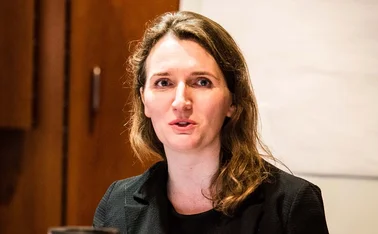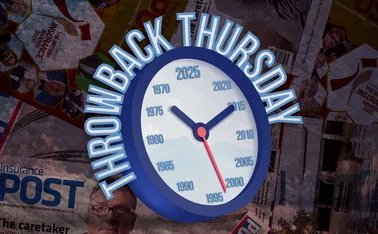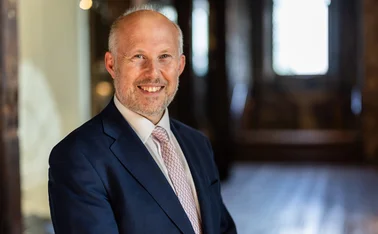
180 Years of Post - The history of direct insurance in the UK: How Direct Line and Churchill took on the establishment and ended up as merger partners

As Post celebrates 180 years, Post content director Jonathan Swift explores the birth of direct insurance in the UK and how two key early movers Direct Line and Churchill went from rivals to merger bedfellows in a deal that literally 'shook up insurance'.
“Blown up”, “Smashed up”, “Shot at” and “demolished”.
These do not sound like words that you would expect to be used in any conversation about partners for a workable merger.
But they have all been used by former Direct Line employees – from information garnered second hand – to describe an almost mythical event that was a highlight of early annual Churchill staff parties. Namely the ceremonial destruction of a model of their competitor’s red phone brand icon.
From these conversations the image painted is one of the Churchill staff setting about the phone with the zeal and abandon you’d expect from hordes of children at a birthday party hitting a piñata to access the enclosed sweets. Except this time the people with sticks were literally destroying something that symbolised their closest competitor.
Talking to those that were actually there the truth might been even stranger than that fiction, with one ex-employee claiming that at the annual Churchill Anniversary Ball – possibly in June 1995 – a massive red phone was wheeled out [at earlier events it was also reportedly hung from the ceiling] and the 500 attendees were provided with balls to chuck at it until the phone was destroyed. This witness describes the scenes as “pretty spectacular,” given it was topped off with people standing on chairs waving flags a la Last Night of The Proms to the music of Elgar culminating with a hearty sing-song to Rule Britannia.
Named contributors – latest role with the relevant organisation and dates employed pre-merger listed:
- Emma Banks, PR assistant, Churchill, 1992 – 1994; and head of PR, Direct Line, 2002 – 2003
- Colin Batabyal, general manager motor business, Direct Line, 1994 – 2000
- Andrew Blowers, founder and group managing director, Inter Group, 1992 – 2001, executive director, Churchill, 2001 – 2003
- Phil Bunker, managing director, NIG, 1990 – 2003
- Geoff Carter, commercial director/partnerships director, Churchill, 1995 – 2003
- Charles Crawford, executive director, Churchill, 1993 – 2003
- Selwyn Fernandes, head of pricing, 1993 – 2000, then technical director, international division, Direct Line, 2000 – 2003
- Peter Graham, project manager, Direct Line, 1993 – 1996
- Simon How, consultant, Direct Line, 1994 – 1999
- Martin Long, CEO and chairman, Churchill, 1989 – 2003
- Bill Miller, director of projects and ops support, Direct Line, 2000 – 2003
- John O’Roarke, managing director, Churchill, 1990 – 2003
- Mike Quinton, managing director, general insurance, Prudential, 1983 – 2001 then managing director, corporate partnerships, Churchill, 2002 – 2003
- Andy Webb, executive director, customer operations, Churchill, 2000 – 2003
Eight years later Direct Line and Churchill would merge and become bed fellows, in a deal between two companies that together had logged just over a quarter of century of trading. But in their short life times had been key players in the seismic shift in the insurance market away from the broker to the phone, and then online.
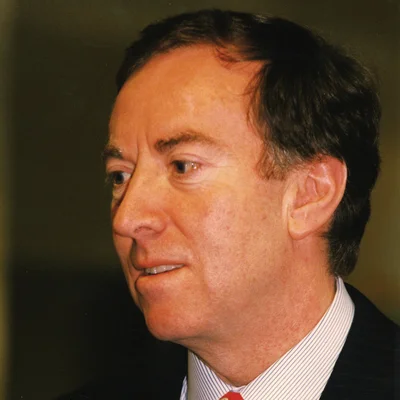
First out of the blocks was Direct Line, a joint venture involving entrepreneurs Peter Wood (occupation given as ‘business executive’ according to Companies House with past directorships including Howden Management and Data Services Ltd and Twentieth Century Press Limited), Martin Long (occupation given as ‘insurance underwriter’ with a past directorship at Halifax Insurance Company Limited) and RBS.
“I was managing director of Halifax Insurance in the early eighties. I was 33 and had been in insurance my entire working life when I got a phone call from Peter,” recalls Long. “He explained how he was setting up this new concept [of direct insurance] which chimed with me because I’d been quite vociferous that there had to be a better way of doing insurance than the way we had all been doing it. Which was via brokers, giving them loads of commission, and customer service that was, to put it bluntly, crap.”
The two met up, and connected resulting in Wood bringing in some of his IT team from his former employer, Lloyd’s broker Alexander Howden, to work on what became Direct Line.
“When I told my ex-boss what I was planning to do he warned me ‘don’t do this, you’ll never work again,’ Long adds. “And I responded ‘I don’t really want to work in the insurance industry if it is this tatty; I’d rather buy a hotel and enjoy myself’.
Peter Graham, who would eventually join Direct Line in 1993, was intrigued by the start-up but admits an early interview there did not go too well.
“I was a computer programmer working for British Gas in Croydon and I was looking for my next job and went to see this insurance company no one had ever heard off called Direct Line, which was also based in the town. It was 1986, a year after they’d launched,” he recalls.
“At that time as a fairly junior computer programmer you needed to get certain things on your CV, for instance structured systems analysis and design methodology [an approach to the analysis and design of information systems approved by the government office Central Computer and Telecommunications Agency].
“But when I went to see Direct Line it said ‘we don’t do any of that stuff here, we just code it and check it into production. If it doesn’t work we’ll go again’. And at that time it hardly had any customers so it didn’t matter. So I thought to myself do I want to join this bunch of cowboys who seem to be winging it. It felt far too relaxed and leisurely for me.”
Before the red phone
However, in the days before the red phone it was Direct Line’s first television campaign that really drove the nail into Graham’s career with Direct Line.
“What topped it off, was that I was shown into Peter Wood’s office and told 'we want you to watch our latest TV advert'. So they sat me down and showed me an ad with Noddy and Big Ears in a phone box and I thought, 'you’ve got to be kidding me’. They made me an offer but I declined.”
By the time Graham eventually begun at Direct Line he remarks they “certainly had procedures in place” and Enid Blyton’s fictional Toyland duo had been shelved in favour of the phone on wheels (See Box).
Speaking to Post in 2014 about the early days of Direct Line, Wood indicated that many consumers shared Graham’s pessimism about the potential for the insurer: “At the time, it was an alien idea to both insurers and consumers. There were times when I had to lock the door and kick a toy cat I used to keep in my office (I’ve still got it) out of frustration, but once consumers bought into a new way of doing things, it gained its own momentum and the world changed. I’m proud of that, and I believe the consumer was the greatest beneficiary.”
Direct Line was only two years old when one of its founding directors Long resigned [21 July 1987] before setting up rival and future merger partner Churchill.
“We had a great start and everything was working out, but to be frank I did not really get on with the hierarchy at RBS and it seemed they liked me either,” Long explains.
“So it was one of those things. Best to go. I was only there for a couple for years, but we had set it all in motion and [Direct Line] was achieving great things, with a strong brand, wonderful growth and most importantly it was doing things differently.”
When it came to seeking a backer for Churchill with the £25m he needed, Long was adamant about one thing it had to be – neither a UK-based insurance company or bank because they “are run by idiots” and “customer service was an anathema to them”.
“[Consultancy] McKinsey had been into Direct Line so I knew someone there and rang them up and asked if they could think of anybody who would be interested in setting up a direct response company,” Long continues. “They told me not to go anywhere else and after two days rang back and suggested [Swiss-based insurance group] Winterthur. So I went and met them and we got on. It wanted to be in the UK, liked the idea of direct insurance but the conclusion of the McKinsey study was don’t do it until you know someone who can. And so it was just fate that I happened to be on the end of the phone when they finished that research.”

Colin Batabyal was fascinated by the potential for telephone-based insurance, despite a climate where rumours abounded about how ‘too-good-to-be-true Direct Line’ was to – excuse the pun – an accident waiting to happen. Although his first foray into the direct market working with the nascent Churchill was less than successful.
“I joined Churchill because I thought direct insurance was the way to go; and at the time Direct Line was not advertising any roles that appealed to me. But that did not work out so I went to Norman [now Covéa].
“However, in 1994 Direct Line advertised a role that might as well have said ‘Colin this is for you’, so I applied, got the job and it was so different [to anywhere I’d worked before]. There was an edge to being at Direct Line in that lots of people said we were under reserved which was so far from the truth, in fact as the years progressed the accountants said we had to release reserves otherwise we’d run into problems with the tax man.
“I knew various people in the market and suddenly because I was at Direct Line they all wanted to talk to me. They wanted to know what I had to say. It was all ‘what do Direct Line do here? what do they do there?’ it was very strange.
“There were so many crazy rumours flying around. One was that we had a target for Ford Sierras, and if we had not written enough of them on any given day we’d cut the rates the next but it was nonsense. In fact the underwriting was not that sophisticated, certainly when I first joined. We got better, but we just used the standard Association of British Insurers’ ratings until I introduced a 99 car group system because I felt we should be more sophisticated.”
Direct revolution
Someone else who left a traditional insurer to join the direct revolution was Charles Crawford, who had agreed to join AA Insurance from Royal in 1993 when he took a call from the late Ed Snell at IPS.
“He rang me up and said, ‘I’ve got this job at Churchill are you interested?’ And I told him I was working out my notice to join the AA, but he insisted I came in. So I met this guy called Bob Leslie, who was the operations and underwriting director, and I had a really great chat but in a fortnight I was joining the AA in Basingstoke, so they needed to offer me a job within the week. Ten days later I started at Churchill having gone back within 48 hours and met [chairman and CEO] Martin Long. There waiting for me in the car park on my first day was a new BMW 318, it was astonishing”.
Like Batabyal, Crawford found that Churchill was – to begin with – not too far ahead of the curve when it came to the use of data in underwriting, although it did have one major advantage – speed.
“You look at all these software tools that everyone uses [today] in terms of the analytics and data sets. We didn’t have huge data sets. But we did have fast pricing. I used to go to work every single Sunday because you had no access to this stuff remotely and run the stats on quotes, sales and conversions, renewal retention and make recommendations for [managing director] John [O’Roarke] and Martin [Long] on pricing,” he remembers.
“You'd put them into the system, test them and they’d be live the following morning. We did not have the whole rating lag of sending rates back to software houses on floppy discs and then pushing them out. We had no printed guides. But each day, each week you’d see trends. You saw who was renewing, who was not renewing, and we could act.”
Crawford adds: “When I joined Churchill it had data but it was all one dimensional in that we’d look at age, type of car, or the postcode [of the policyholder]. But we started looking at two or three dimensional rating, bringing in lifestyle factors – from the likes of Equifax and Experian – and I sense Direct Line and Churchill moved forward together, independently, on this in that they were both thinking about being more intelligent with rating.”

By Direct Line’s tenth anniversary, a birthday celebrated with a lavish event in Birmingham hosted by comedian, the late Victoria Wood, the business was literally – as one ex-employee put it “going gangbusters” despite whispers about the durability of the business model.
Whether the insurance broking community was the source of some of the unwelcome speculation and gossip about ‘sharp practices’ is undocumented, but it would not have been surprising given the reaction from some intermediary big wigs.
The Institute of the Insurance Brokers under the auspices of its director general, the late Andrew Paddick, was very vocal in his criticism of the competition standing on stage at a conference in military garb and challenging “Who do you think you are kidding Mr Wood?”.
But resistance was often futile as Simon How recalls: “[Direct Line director] Mike Flaherty tells a great story from about 1995 when he was living in Beckenham. He had just driven home from Croydon, parked his car up and saw his neighbor sitting on the wall crying at six o clock in the evening. So he went over to console him, but when he asked what the matter was, he responded: ‘I am an insurance broker and those bastards at Direct Line have put me out of business.’”
But despite the clamour created by the likes of Paddick, the potential disruption being caused by the likes of Direct Line and Churchill was perhaps underestimated by many.
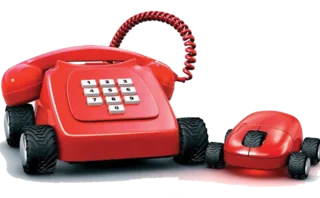
The iconic brands
Direct Line and Churchill had very distinctive brand logos, which as highlighted by the story of the red phone being smashed up by its rival opposite illustrates how significant they became for either business.
As John O’Roarke concedes: “We were envious of the appeal of [Direct Line’s] red telephone on wheels – which was the main catalyst for us to develop our own icon to compete with it – the Churchill bulldog”.
“We started off without an icon and then everybody – all the insurance companies – piled into the direct market thinking it was a license to print money, which it wasn’t,” Long continues.
“So on one famous Tuesday in January 1999 the Daily Mail had 17 different adverts for car insurance and I said ‘we have just got to have an icon to make us stand out and if you’re called Churchill the obvious one is a bulldog’.”

Too fierce
Long notes that to start Churchill used a real bulldog, but customer research found that people didn’t like it.
“They thought it was a bit fierce and was protecting us, the insurance company, from the customers,” adds Long. “Which was the reverse of what we wanted them to say. So it went through various iterations until we came up with the [toy] nodding dog you see now, which worked.”
“The [Churchill] dog was a bit like the [Compare the Market] meerkats of its day,” Geoff Carter comments. “It was astonishingly powerful as a pull. I remember the first time [Churchill] went animatronic and the fuss from people because we had changed him and he was doing things he never previously did. They did not like it because that was not what [they considered to be] the Churchill dog.”
“We had countless arguments with the design agency about whether the dog could walk or not,” says Andrew Blowers. “It was quite amusing, they were adamant that it would destroy the Churchill brand if the toy dog could be seen to walk. But a few years later, post Direct Line merger he was strutting his stuff so they soon got over that.”
Direct Line had similar issues trying to move on and evolve its iconic brand mascot too. Although the familiar shot of the red phone flying in the air was actually an accident according to Peter Graham, who says the person operating the remote control phone when filming had it going too fast and lost control, but the management loved it so much they kept it in.
“Towards the end of my time at Direct Line we’d spend hours, days and months discussing where we were going to take this because it is a red phone on wheels,” adds Colin Batabyal.
“And everything was moving towards the internet so we wondered how we could stretch it [to represent an online brand]. So we introduced the red mouse on wheels. We also had the telephone house as well [to promote household insurance] because the red phone on wheels looked like a vehicle. And it all worked because people had got used to the brand and the red phone and so it was very, very strong.”
Post-acquisition, one initiative that caused some consternation, or as Emma Banks describes it, “a big hoo-ha” was when RBS tried to put its own ‘snow flake’ logo on all the Churchill and Direct Line marketing. Indeed, then marketing executive the late Guy Hedger is understood to have been so opposed to the idea it was a major factor in his departure from RBSI.
“It was strange because you had this pressure from the bank which was trying to stamp its corporate identity on the businesses,” Banks comments. “It had its troubles later on, but at the time RBS was all powerful and thought it knew best, even in insurance, but was blurring the lines between two distinctive and well-known brands.”
Evidence of how far the brands permeated can be illustrated by an anecdote from Long who jokes: “When the [nodding] dog came out [my children] were still at school and if they got an answer wrong the whole class [imitating Churchill] would go, ‘oh no, no, no...’. It took on a life of its own.”
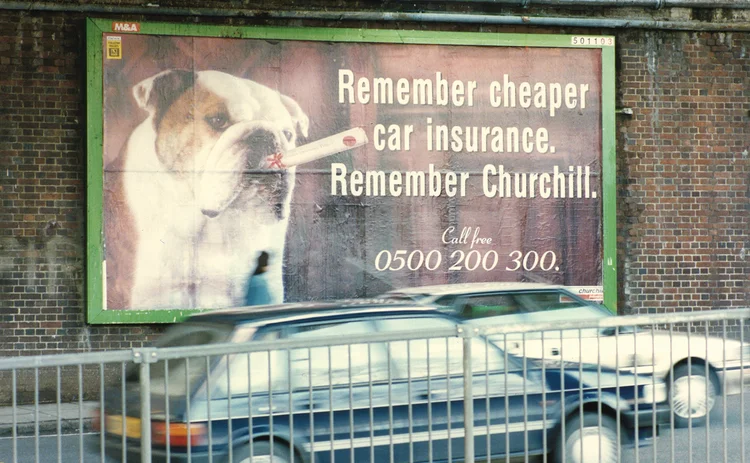
Only users who have a paid subscription or are part of a corporate subscription are able to print or copy content.
To access these options, along with all other subscription benefits, please contact info@postonline.co.uk or view our subscription options here: https://subscriptions.postonline.co.uk/subscribe
You are currently unable to print this content. Please contact info@postonline.co.uk to find out more.
You are currently unable to copy this content. Please contact info@postonline.co.uk to find out more.
Copyright Infopro Digital Limited. All rights reserved.
As outlined in our terms and conditions, https://www.infopro-digital.com/terms-and-conditions/subscriptions/ (point 2.4), printing is limited to a single copy.
If you would like to purchase additional rights please email info@postonline.co.uk
Copyright Infopro Digital Limited. All rights reserved.
You may share this content using our article tools. As outlined in our terms and conditions, https://www.infopro-digital.com/terms-and-conditions/subscriptions/ (clause 2.4), an Authorised User may only make one copy of the materials for their own personal use. You must also comply with the restrictions in clause 2.5.
If you would like to purchase additional rights please email info@postonline.co.uk


